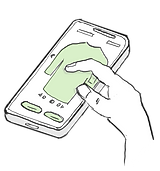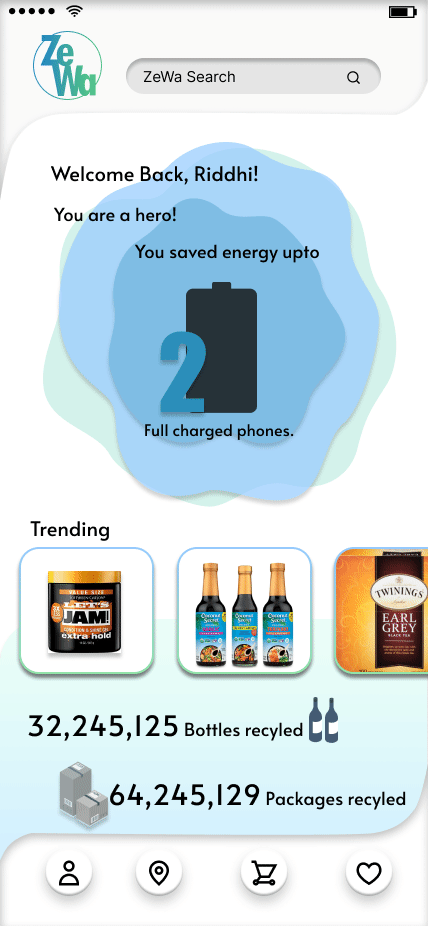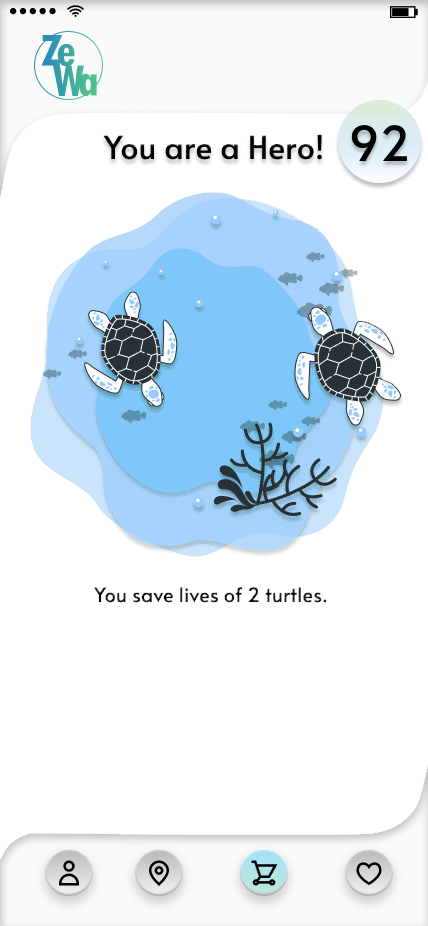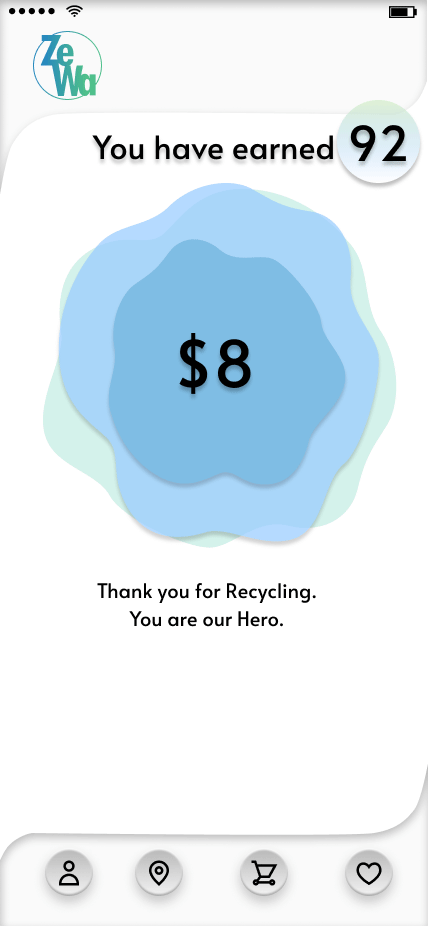

ZeWa
Service Design, UX and UI Design
A service that empowers people to act sustainably, and is aims to eliminate single-use packaging hereby achieving Zero Waste.
People are aware of climate change as it is evident around them. While they want to save the planet, their surroundings make it difficult.
The Global buying Green Report 2021 suggests that 83% of younger consumers are willing to pay extra for eco-friendly and sustainable products. But fewer than 1 in 3 consumers deprioritized sustainable packaging due to covid-19. Research also suggests that eco-friendly and sustainable products and companies are finding it difficult to sustain as a business as consumers find it inconvenient to use them. This project speculates the consumer buying psychology and attempts to find a solution that can be easily adaptable by the consumers and create a good experience.
Team:
1 Designer
Role:
Research, Ideation, and Prototyping
Tools:
Hand Sketching, Figma, Illustrator, and Photoshop
Time:
2 months
The Back-Story

It all started with a milk can..
After I moved out of my country for grad school, I started saving the used milk cans, thinking ' its too good to trash them, instead I re-use it some day.'
And by end of months I was left with of these, and did not know what to do, but to trash them.
While I was feeling guilty I decided to take an anonymous survey to understand what people think.

Discovery Research
Anonymous Survey to understand what people think about sustainability.
What acts of sustainability have you been involved in/used?
I shared an online survey with 18 people of age 22 years and above.
How often do you shop? (includes consumer goods other than groceries)
What is sustainability to you?
How often have you known whether the product you are purchasing is sustainable?
What makes you choose other products over sustainable products?

My hypothesis came true as most people mentioned that they were not able to be sustainable due to their surroundings.

Interviews
I decided to interview major stakeholders, which consist of 66% of the total consumer population.

Millennial - Students

Millennial - Proffesionals

GenZ- Students
Empathy Map
The interview was then mapped into an empathy map to draw out the existing trends in consumer shopping behavior.

The SIX major pain points were recorded from the interview.
“while throwing trash, if I could segregate and giveaway the important pieces to people in need."

“ I feel guilty to trash the things that I use.”

“Sometimes when brands say they are sustainable, I want to know how much sustainable are they? (transparency)”

“I would prefer to go to the store that sells sustainable/eco-friendly, buy things there without even thinking about it.

“I decided to buy products for long term use, I segregate my waste, but I dont know what happens after.”

“Sustainable products are expensive than other products in the market.”

The Literature review

of consumers still find themselves environmentally aware.

of consumers among younger generations showed a willingness to
pay more for sustainable packaging.

of consumers find recyclability of packaging important; however, their actions don’t speak the same language
Market Research

Opportunity Statement
Based on my research, which includes interviews, surveys, and a literature review, I have found that consumers tend to focus on sustainability at the end of their shopping journey after they have already used the product. Many express feeling helpless when it comes to properly disposing of the product.
How might we help users make informed decisions about being eco-friendly while going about their shopping experience?
Jane is a grad student who prefers cooking her own meal and loves growing indoor plants. She shops once in two weeks. She buys what she needs. She wants to help save the planet and she does her bit by getting her own bag to the store and reusing single-use packed plastic. She is looking for ways to reduce waste.

Ideation
The process where I just focused on the quantity of ideas.
Creating rules for the brands with respect to their packaging. The packaging provides information about the product and informs consumer about their choice.
Make a recycle subscription with the stores, where if the customer gets back the packaging, they get some incentive on the next purchase.
The Exchange Program. Exchange your items with others, without currency exchange.
Create a platform which connects people that help reuse, recycle and repair. The person gets some incentive when they choose either of the option.
Programs for people to make them understand that sustainable decisions should be made earlier in the purchase journey to avoid throwing away ‘guilt’ later.
Designing eco-friendly sustainable product that looks like regular product and not pricy or different.
Designing products which look easy to repair or provide a manual which guides people to repair it by themselves when its faulty.
An app which scans the barcode and saves the product. It saves the product warranty, repair, reuse, and refurbishment solutions.
Glorify the idea of thrifting.
Providing a kiosk in the shopping places where people can compare their purchase and make smart and eco friendly decisions before their purchase.
An app that tracks your daily activity like walking to school. It gives incentive whenever you choose eco-friendly option over other. The incentives can be used for product purchase.
Store that only sells sustainable products for the people.
Selling loose items and expect consumers to get their own packaging. Provide glass/paper alternatives for the storage.
An app or platform which compares the durability, repairability and recyclability of the product and help customers take informed decisions.
An initiative from the store that educates their customer about their product journey and its impact on the environment. Lifestyle brands.
Government initiatives where people are made aware about the segregating their trash at source.
I segregated my ideas into 3 major categories.
1. Things to do before buying consumer goods.
2. Things to do after buying consumer goods.
3. Awareness Programs for consumers.
I decided to explore ideas that belonged to categories 2 and 3 as people are aware of sustainability and it is time for them to act. And here goes my concepts..
Concept1: Subscription
This concept is for products that we consume daily and buy more frequently. The consumers subscribe to the product and are delivered in containers at a specific recurring time. The bottles are recycled and given to the consumer.

Jane plans on shopping her biweekly items.


Jane orders the items from the app that she wants it every week. She selects the items and its quantity and checks out.

The order gets delivered in a box with containers.

Jane gives back a set of containers for the future delivery.
Concept2: Refill
The consumer refills the items in a store, where brands sell their products in loose items.

Jane plans on shopping her biweekly items.

Jane plans to go to grocery store, gives back her jars from previous purchase and gets the refillable jars.

Jane refills the items in the jars, measures the weight and checks out.
Concept3: Captain Planet
The consumer buys products, gets green points based on their mindful shopping, with respect to sustainability, and uses these points to save the environment in real through a gamified UI.

Jane plans on shopping her biweekly items.


She goes to the store
She shops online

She checks out her items.


She gets green points if she recycles.
She can collects points by getting her own bag in the grocery store.
She can earn more points by

She collects Green Points for her mindful environment friendly shopping
She gets Green points if she walks/cycle to the school instead of taking a ride.
Use points to save the planet.
Concept4: Scan It
The consumer goes to the store and scans the products to understand how it impacts the environment.

Jane plans on shopping her biweekly items.
Jane looks at the products in the isle and picks up the product.


She opens the app and scans the product.

She checks out her items.


The app shows how sustainable the product is from its database and user reviews.
User Feedback
I asked the same interviewees which concept they "love" and which they "like".
Subscription

Refill

Captain Planet

Scan It

"Cleaning can be messy. Also a great option to get it delivered."
"Recycling event assosciated
build culture for recycle.
exchange items."
"The recycling bottles is easy and dont have to carry weight."
"Limited range of products."
‘Refillables can’t solve today’s consumer problems’.
Convenience over cause
https://packagingeurope.com/comment/refillables-cant-solve-todays-consumer-problems/8060.article
"Packaging turned to furniture / cat box or of some use."
"Not always convenient."
"Can add virtual world and make people feel how it feels in the forest/ clean rivers.
Show their real impact."
"Might not play games on daily basis
not for all age groups
may not me easy to understand."
"Don’t give away points so easily. "
Helps people join the sustainibility movement.
Slows down the shopping process.
Overwhelmed by the information.
If we could add a filter and would only show the products which fall under the list while shopping.
More Information (mental load)
Seems more practical.
Ui of your carbon footprint.
I took some decisions:
-
Focusing on daily use products.
-
Aiming for zero waste.
-
Motivate people to make wise decisions keeping the environment as their preference.
-
Make a culture.

A service that encourages and empowers people to act sustainably, hereby achieving Zero Waste.
Introducing...
User Experience with ZeWa..



Riddhi opens the app to shop, and gets happy by seeing the impact she is creating with her smart decisions.




Riddhi checks out her items and feels great to see the impact she created and earns some points. Here money for the packaging is deducted.






She reaches the ZeWa kiosk and scans the barcode to recycle the packaging.

The manufacturer refills the packaging.
1. Save the planet

Saves the planet by developing the VR world by planting trees, which will be planted in real by ZeWa Volunteers


Riddhi plans on shopping for a few items from the store.




Riddhi uses the items and when the packages get empty she decides to recycle them.

ZeWa collects all the packaging, cleans it, and sends it to the manufacturer.
How to use the green points?

Riddhi can collect and redeem her points in two ways.
2. Save the pocket

Saves pocket by availing discounts from your favourite brands.
The service can work well if the manufacturer and the credit card company join ZeWa.

Partner 1: Asking brands to pack in a sustainable and reusable packaging

Partner 2: Credit card company to help with the purchase data.
Reflection
In the future, I would like to develop the Uis for the virtual gaming world, where people can create virtually, which will signify the impact that they create in real life. I would also want to redesign the packaging such that people take pride in recycling.
I wish I could test the final product, which will help me in understanding where I need to iterate. Through this project, I learned how to create a sustainable ecosystem that can solve the reusable system. I wish I had more time to rework my UIs.
Attribute
I would like to thank Nick Ashley and my professor Jon White for providing guidance on this project.